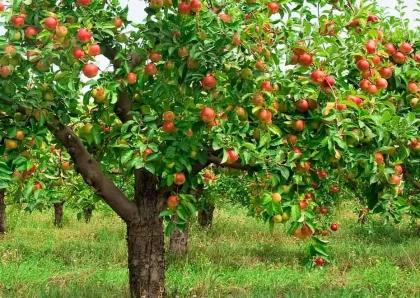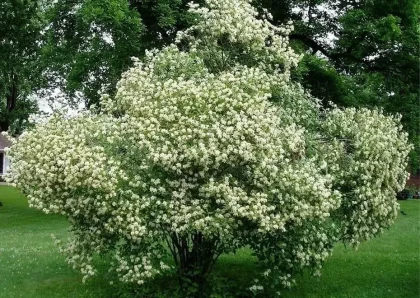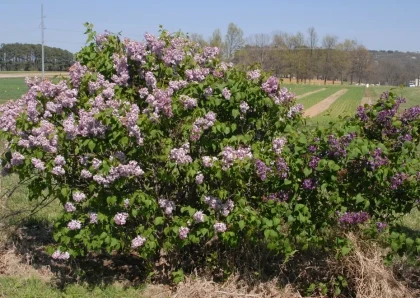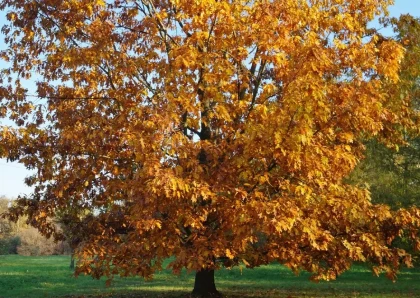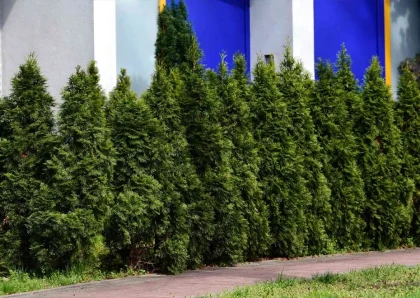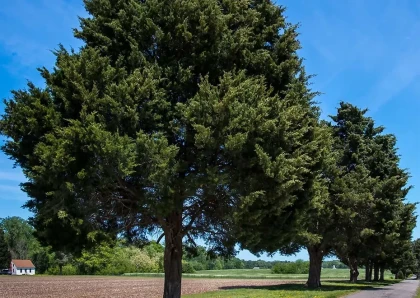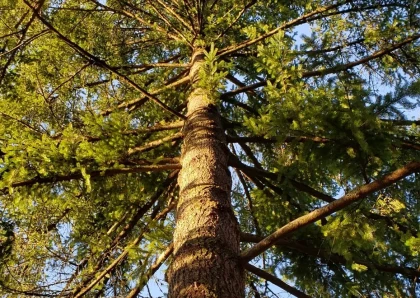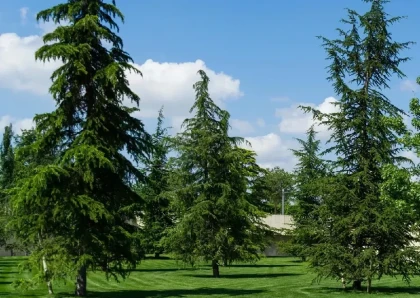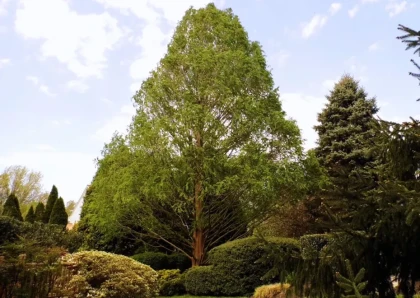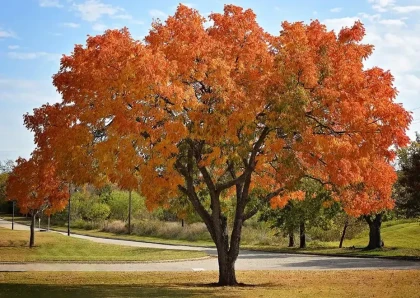
Colorado Blue Spruce Tree
Overview
The Colorado Blue Spruce, scientifically known as Picea pungens, is a species of coniferous tree belonging to the Pinaceae family. It is native to the western United States, specifically the Rocky Mountains region, including Colorado, Utah, Wyoming, and parts of New Mexico.
This tree is well-known for its striking blue-gray to silvery-blue needles, which give it its common name, "Colorado Blue Spruce." The needles are four-sided and can be quite sharp, so caution should be exercised when handling the tree.
Colorado Blue Spruce trees are popular in landscaping and ornamental plantings due to their attractive color and dense, symmetrical shape. They can reach heights of up to 70 to 100 feet (21 to 30 meters) when fully mature, with a spread of about 10 to 20 feet (3 to 6 meters). Their conical form makes them visually appealing in gardens and urban landscapes.
In addition to their aesthetic value, Colorado Blue Spruces also provide habitat and food for various wildlife, including birds and small mammals. These trees are hardy and adaptable, thriving in a range of soil conditions and climates, making them well-suited for many different environments.
Types of Colorado Blue Spruce Trees
1. Colorado Blue Spruce (Picea pungens glauca)
This is the most common and widely recognized type, known for its striking silvery-blue to blue-gray needles.
2. Baby Blue Eyes (Picea pungens 'Baby Blue Eyes')
This cultivar is smaller than the standard Colorado Blue Spruce, with a more compact and dwarf-like growth habit. It retains the characteristic blue color.
3. Hoopsii (Picea pungens 'Hoopsii')
Hoopsii is a larger cultivar with a broader, more open form. Its blue color is intense, making it a standout in landscapes.
4. Fat Albert (Picea pungens 'Fat Albert')
Fat Albert is a popular cultivar known for its dense, pyramidal shape and vibrant blue needles.
5. Globosa (Picea pungens 'Globosa')
This variety is low-growing and mounded, forming a dense, rounded shape with blue foliage.
6. Montgomery (Picea pungens 'Montgomery')
Montgomery is a slow-growing cultivar that develops into a compact, globular shape with silvery-blue needles.
7. Koster (Picea pungens 'Koster')
The Koster cultivar features a slightly more greenish-blue color compared to the standard blue spruce, but it is still considered a beautiful variety.
8. Weeping Blue Spruce (Picea pungens 'Pendula')
This is a unique weeping form of the Colorado Blue Spruce, where the branches droop gracefully towards the ground.
9. Iseli Fastigiata (Picea pungens 'Iseli Fastigiata')
This cultivar is valued for its narrow, columnar shape, making it a great choice for smaller spaces.
10. The Blues (Picea pungens 'The Blues')
This cultivar has a more steel-blue coloration, setting it apart from the standard blue spruce.
Wood Products from Colorado Blue Spruce Trees
- Lumber: Colorado Blue Spruce wood is used to produce lumber for various construction and woodworking purposes. The wood is known for its strength, stability, and beautiful appearance, making it suitable for applications such as framing, flooring, and paneling.
- Plywood: Plywood is often manufactured using the veneers of Colorado Blue Spruce wood. It is commonly used in interior applications, such as furniture making, cabinetry, and decorative paneling.
- Millwork and Moldings: Colorado Blue Spruce wood can be crafted into millwork and moldings, which are used for trim, decorative accents, and architectural details in buildings.
- Doors and Windows: The wood from Colorado Blue Spruce can be used to manufacture doors and window frames, offering a sturdy and visually appealing option for homes and buildings.
- Furniture: Colorado Blue Spruce wood is used by furniture makers to create various pieces, including tables, chairs, and cabinets. The wood's color and grain pattern can add an elegant touch to furniture designs.
- Musical Instruments: The resonance and tonal properties of Colorado Blue Spruce wood make it a favored choice for building certain musical instruments, particularly acoustic guitars, pianos, and violins.
- Wood Crafts: Craftsmen and artisans use Colorado Blue Spruce wood for creating a wide range of woodcrafts, including carvings, sculptures, and decorative items.
- Pulp and Paper: The wood from Colorado Blue Spruce is also used in the pulp and paper industry to produce high-quality paper products, including fine writing paper and specialty papers.
- Utility Poles: The strength and durability of Colorado Blue Spruce wood make it suitable for manufacturing utility poles used in power transmission and distribution.
Benefits of Colorado Blue Spruce
- Aesthetic Appeal: One of the primary reasons for planting Colorado Blue Spruce is its striking appearance. The blue-gray to silvery-blue needles give the tree a unique and eye-catching color, making it an attractive focal point in gardens and landscapes.
- Evergreen Nature: Colorado Blue Spruce is an evergreen conifer, meaning it retains its foliage year-round. This quality provides consistent greenery and adds visual interest to landscapes, particularly during the winter when other deciduous trees have shed their leaves.
- Windbreak and Privacy: The dense, conical form of Colorado Blue Spruce trees makes them excellent windbreaks, helping to reduce wind speeds and protect nearby structures and plants from harsh winds. Additionally, their tall and thick foliage offers privacy when used as a hedge or screening tree.
- Wildlife Habitat: Colorado Blue Spruce provides habitat and shelter for various wildlife species. Birds and small mammals often use the tree for nesting and seeking protection from predators and inclement weather.
- Erosion Control: Planting Colorado Blue Spruce trees on hillsides and slopes helps control soil erosion, as their extensive root systems help stabilize the soil and prevent erosion caused by runoff.
- Shade and Cooling: While not as large as some other tree species, mature Colorado Blue Spruce trees still provide some shade, which can be beneficial in cooling urban and suburban environments during hot summer months.
- Low Maintenance: Once established, Colorado Blue Spruce trees are relatively low maintenance. They are drought-tolerant and generally resistant to pests and diseases, reducing the need for frequent care.
- Soil Improvement: As with many other trees, the fallen needles of Colorado Blue Spruce contribute to the organic matter in the soil, enhancing soil health and fertility over time.
- Carbon Sequestration: Trees, including Colorado Blue Spruce, play a crucial role in carbon sequestration, absorbing carbon dioxide from the atmosphere during photosynthesis and storing it as carbon in their biomass.
- Longevity: When properly cared for, Colorado Blue Spruce trees can live for several decades, providing long-term benefits to the environment and landscapes.
Tips for Planting and Maintaining Colorado Blue Spruce
Planting
- Site Selection: Choose a location with full sun to partial shade and well-draining soil. Colorado Blue Spruce prefers slightly acidic to neutral pH levels.
- Spacing: Give the tree enough space to grow to its full size. Mature Colorado Blue Spruce trees can have a spread of 10 to 20 feet, so ensure they have enough room to grow without crowding other plants or structures.
- Digging the Hole: When planting, dig a hole that is about twice the size of the root ball. This will provide enough space for the roots to spread and establish in the soil.
- Amend the Soil: If the soil is poor, amend it with organic matter like compost to improve its structure and fertility.
- Planting Depth: Plant the tree at the same depth it was in the nursery container. Avoid planting it too deep, as this can lead to root rot.
- Mulch: Apply a layer of mulch around the base of the tree, but avoid piling it against the trunk. Mulch helps retain moisture, regulate soil temperature, and suppress weeds.
- Watering: Water the newly planted tree regularly to help it establish its root system. Once established, Colorado Blue Spruce is moderately drought-tolerant, but it's still essential to water during dry periods.
Maintenance
- Watering: During the growing season, water the tree deeply but infrequently. Allow the soil to dry slightly between waterings. Avoid overwatering, as this can lead to root rot.
- Fertilization: Colorado Blue Spruce generally doesn't require frequent fertilization. However, if the tree shows signs of nutrient deficiencies, you can apply a balanced, slow-release fertilizer in the spring.
- Pruning: Minimal pruning is generally needed for Colorado Blue Spruce. Remove any dead, damaged, or diseased branches. Additionally, thinning the interior branches can improve air circulation and light penetration.
- Pest and Disease Management: Colorado Blue Spruce is susceptible to certain pests and diseases, such as spruce spider mites, adelgids, and needle cast diseases. Regularly inspect the tree for any signs of issues and take appropriate measures if necessary.
- Winter Protection: Young Colorado Blue Spruce trees may benefit from winter protection, especially in colder regions. Use burlap or tree wraps to shield the tree from harsh winter winds and sunscald.
- Avoid Stress: Avoid excessive foot traffic around the tree, as compacted soil can hinder root growth. Be mindful of construction activities near the tree, as root damage can negatively impact its health.
Cons of Planting Colorado Blue Spruce
- Large Size: Colorado Blue Spruce can grow quite large, and this may not be suitable for small yards or limited space. As they mature, their branches can extend widely, which may lead to potential conflicts with nearby structures, power lines, or other plants.
- Slow Growth: Colorado Blue Spruce is a slow-growing tree, especially in its early years. It may take several years or even decades for the tree to reach its full size and maturity.
- Prone to Insect Pests and Diseases: While relatively hardy, Colorado Blue Spruce is susceptible to various insect pests and diseases. Common issues include spruce spider mites, adelgids, needle cast diseases, and cytospora canker. Regular monitoring and appropriate management are essential to prevent and control these problems.
- Environmental Requirements: Colorado Blue Spruce has specific environmental requirements to thrive. It prefers well-drained soil and may struggle in poorly drained or compacted soils. It is also not well-suited to hot and humid climates, and in such regions, it may be more susceptible to stress and diseases.
- Needle Drop and Messiness: Like many evergreen trees, Colorado Blue Spruce will naturally shed needles, which can create a mess in the landscape. Regular needle drop can lead to a build-up of debris and may require periodic clean-up.
- Allelopathic Effects: Some studies suggest that Colorado Blue Spruce produces chemicals that inhibit the growth of certain understory plants. This can limit plant diversity and natural regeneration in the immediate vicinity of the tree.
- Non-Native in Some Regions: In certain regions, Colorado Blue Spruce is considered non-native and may become invasive in natural habitats. Planting non-native species can have negative impacts on local ecosystems and wildlife.
- Landscaping Maintenance: The dense and sharp needles of Colorado Blue Spruce can make landscaping maintenance, such as lawn mowing or weeding, a bit challenging and potentially hazardous.
Conclusion
Colorado Blue Spruce (Picea pungens) is a popular and visually stunning evergreen tree with distinctive blue-gray to silvery-blue needles. It is valued for its aesthetic appeal, especially as a focal point in gardens and landscapes. Additionally, its evergreen nature provides year-round greenery, making it visually attractive during all seasons.
While planting Colorado Blue Spruce offers numerous benefits, there are also important considerations to keep in mind. The tree's large size and slow growth may not be suitable for smaller yards or limited spaces. Furthermore, it is essential to be aware of potential pest and disease issues and to understand its specific environmental requirements to ensure successful growth and longevity.
Proper care and maintenance, including watering, pruning, and protecting the tree during harsh winters, are crucial for its health and longevity. Furthermore, attention should be given to prevent potential invasiveness in non-native regions and to manage its allelopathic effects on understory plants.
In summary, Colorado Blue Spruce can be a beautiful addition to the landscape when planted in the right location and cared for properly. Its unique color and evergreen nature make it a visually appealing choice, but careful consideration of its size, growth rate, and environmental requirements is necessary for successful cultivation. By understanding its advantages and potential challenges, individuals can enjoy the benefits of this magnificent tree while promoting a thriving and sustainable landscape.
FAQs
1. What is Colorado Blue Spruce?
Colorado Blue Spruce (Picea pungens) is an evergreen coniferous tree known for its striking blue-gray to silvery-blue needles. It is native to the Rocky Mountains of the United States and is widely cultivated for ornamental and landscaping purposes.
2. How tall does Colorado Blue Spruce grow?
Colorado Blue Spruce can grow to be quite tall, reaching heights of 50 to 75 feet (15 to 23 meters) or more at maturity. However, the growth rate is relatively slow, and it may take several decades to achieve its full height.
3. What are the different types of Colorado Blue Spruce trees?
There are several cultivars and varieties of Colorado Blue Spruce, each with its unique characteristics. Some popular types include 'Glauca,' 'Hoopsii,' 'Fat Albert,' 'Montgomery,' and 'St. Mary's Broom.'
4. Is Colorado Blue Spruce suitable for small yards?
Due to its large size at maturity, Colorado Blue Spruce may not be the best choice for small yards or limited spaces. It requires ample room to grow and spread its branches without crowding other plants or structures.
5. How do I care for Colorado Blue Spruce?
Proper care for Colorado Blue Spruce includes planting it in well-draining soil, providing adequate watering during its establishment phase, and ensuring it receives full sun to partial shade. Regular pruning, pest monitoring, and winter protection are also essential for its health and longevity.
6. What pests and diseases are common in Colorado Blue Spruce?
Colorado Blue Spruce can be susceptible to various insect pests, including spruce spider mites and adelgids. Needle cast diseases and cytospora canker are among the common diseases that may affect this tree. Regular inspections and appropriate management are necessary to address these issues.
7. Can I plant Colorado Blue Spruce in any climate?
Colorado Blue Spruce thrives in cold to temperate climates with well-defined seasons. It is best suited for regions with cool summers and cold winters. It may struggle in hot and humid climates, as well as areas with poorly drained or compacted soils.
8. Does Colorado Blue Spruce require much maintenance?
Once established, Colorado Blue Spruce is relatively low-maintenance. However, regular care, such as watering during dry periods, occasional pruning, and monitoring for pests and diseases, is necessary to ensure the tree's health and appearance.
9. Can Colorado Blue Spruce be used as a windbreak or privacy screen?
Yes, Colorado Blue Spruce's dense and conical form makes it an excellent choice for windbreaks and privacy screens. When planted in rows, the trees can help reduce wind speeds and provide a visual barrier.
10. Is Colorado Blue Spruce a native tree?
Yes, Colorado Blue Spruce is native to the Rocky Mountains of the United States, primarily found in Colorado, Utah, Wyoming, and parts of New Mexico. It has also been widely cultivated in other regions for its ornamental value.
No listings available
Related Products
Golden Jubilee Peach Tree
Prunus persica 'Golden Jubilee' is a specific cultivar of peach tree. It is a deciduous fruit tree belonging to the Rosaceae family. 'Golden Jubilee'...
Gray Dogwood
Cornus racemosa, commonly known as the gray dogwood or northern swamp dogwood, is a deciduous shrub native to eastern North America. It belongs to...
Common Fragrant Lilac
Syringa vulgaris, commonly known as the Common Lilac or French Lilac, is a deciduous shrub belonging to the genus Syringa in the olive family...
European Beech Tree
The European Beech (Fagus sylvatica) is a deciduous tree species native to much of Europe, including parts of western Asia. It is one of...
Emerald Arborvitae Tree
The Emerald Arborvitae (Thuja occidentalis 'Smaragd') is a popular evergreen tree or shrub in landscaping and gardening. It belongs to the cypress family (Cupressaceae)...
Eastern Red Cedar Tree
The Eastern Red Cedar, scientifically known as Juniperus virginiana, is a species of evergreen tree native to eastern North America. It belongs to the...
Douglas Fir Tree
The Douglas Fir (Pseudotsuga menziesii) is an evergreen coniferous tree that belongs to the Pinaceae family. It is one of the most common and...
Deodar Cedar Tree
The name "Deodar" is derived from the Sanskrit words "deva" (meaning "god") and "daru" (meaning "wood" or "tree"), hence it is often referred to...
Dawn Redwood Tree
The Dawn Redwood tree, scientifically known as Metasequoia glyptostroboides, is a deciduous coniferous tree that belongs to the family Cupressaceae. It is a unique...
Chinese Pistache Tree
Description Overview The Chinese Pistache Tree, also known as Pistacia chinensis, is a deciduous tree that is native to China and Taiwan. It belongs...




